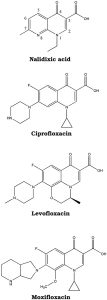Ciprofloxacin 500: Your Go-To Solution for Respiratory Tract Infections
Introduction
Respiratory Tract Infections are a common problem resulting from bacterial and viral causes that can severely impact your quality of life. According to the WHO, respiratory infections cause 6% of the total disease burden, and around 6.6 million children die yearly because of the problem. 95% of these children belong to low-income countries, and about 1/3rd of the deaths occur because of Acute Respiratory Infections. One of the biggest complications caused by pathogen-induced respiratory tract infections is their tendency to become an epidemic or mass-affection if not treated on time.
Considering the above factors, treatment options promptly and adequately are essential to prevent mortality and reduce hospitalization. Penicillins and quinolones were some first-generation antibiotics that favorably worked against bacterial infections. But over time, the pathogens developed resistance to them. Because of this, second-generation antibiotics like Fluoroquinolone were designed to be used in human and veterinary medicine.
Ciprofloxacin is one such Fluoroquinolone effective in many bacterial infections, including urinary tract infections, joint infections, gastrointestinal infections, and sexually transmitted diseases. What makes Ciprofloxacin especially important is its role in respiratory infections that, when improperly treated, can result in fatal complications or spread to other parts of the body.
Ciprofloxacin has proven more effective than Amoxicillin, a penicillin derivative formerly used as a first line of treatment against respiratory infections and regarded as a strong antibiotic.
Ciprofloxacin and Amoxicillin
In a comparative study conducted to evaluate the efficacy of Ciprofloxacin and Amoxicillin for respiratory infections like pneumonia, acute bronchitis, and chronic lung disease, 48 patients were enrolled in the study. Twenty-six patients were enrolled in the ciprofloxacin group and 22 in the Amoxicillin group and administered standard doses of either drug. Clinical and bacteriological criteria were used to determine the response to therapy.
Ciprofloxacin proved as effective as Amoxicillin in reducing the intensity of respiratory infections and had an outcome of 81% compared to the 82% outcome recorded with Amoxicillin. Moreover, eradication rates were higher in Ciprofloxacin in comparison to Amoxicillin. The overall verdict found Ciprofloxacin to be as effective in bacterial respiratory tract infections as Amoxicillin.
An important fact observed in this study was the ineffectiveness of Amoxicillin in two patients infected with Branhamella catarrhalis, a gram-negative aerobic bacteria that causes infections of the upper respiratory tract in humans and children. Also referred to as Moraxella catarrhalis, the pathogen tends to be resistant to Amoxicillin, Penicillin, and Ampicillin.
In such conditions, Quinolones like Ciprofloxacin are effective because of their excellent penetration into the respiratory tract and laryngeal tissues to destroy pathogens effectively. While other antibiotics have limited bactericidal action, Ciprofloxacin exhibits a dual mechanism of action by inhibiting DNA gyrase and topoisomerase IV enzymes that play an important role in the replication and survival of the pathogen.
A word about antibiotic resistance
An essential factor that mars the effectiveness of several antibiotics is antibiotic resistance, caused by chromosomal mutations or mutations causing reduced drug accumulation either by decreased uptake or increased reflux in the system. The presence of antibiotic-resistant genes that block the action of the drugs on the DNA gyrase and topoisomerase further mars their effect and prevents them from exerting their maximum effectiveness.
Quinolones’ binding to the topoisomerase enzyme is mediated through the water-metal ion bridge that mediates drug–enzyme binding directly and does not require a divalent metal ion, working in favor of the medicine. In the case of Ciprofloxacin, its binding is mediated through C2, C7 & C8 substituent groups that form hydrogen bonds with conserved arginine residue and retain activity against quinolone-resistant bacterial enzymes without cross-reacting with the human enzyme.

Image Credit – https://pubmed.ncbi.nlm.nih.gov/21261881/#&gid=article-figures&pid=figure-1-uid-0
What do animal studies say about Ciprofloxacin for respiratory tract infections?
Ciprofloxacin, imitating the mechanism of quinolones, has considerable respiratory tissue penetration and exhibits a postantibiotic effect, making it suitable for a wide range of respiratory tract infections. In animal studies conducted to test its effectiveness, high tissue concentrations of the drug were recorded in the animal’s kidneys, lungs, spleen, liver, and muscle. In contrast, in the healthy animal group, the highest concentrations were achieved in the kidney, liver, lung, spleen, and muscle. The high Ciprofloxacin tissue concentrations indicated that the Ciprofloxacin could prove an excellent drug for treating urinary and respiratory tract infections.
Even a review of thirty-seven published clinical trials of Ciprofloxacin in lower respiratory tract infections showed seventy-four patients with M.Catarrhalis pathogen in the respiratory tract to respond well to the drug and show an eradication rate of 96%. In the same review, twenty-two published cases of bronchitis revealed an eradication rate of 94.5% with Cirofoxacin.
Ciprofloxacin and Bacillus Anthracis
Bacillus Anthracis is responsible for Anthrax, which is spread through infected animals or contaminated animal products and starts in the lymph nodes in the upper respiratory tract before spreading to the rest of the body and causing severe breathing problems with other complications.
Left untreated, Anthrax proves fatal. Even after aggressive treatment, the survival rate after infection is approximately fifty-five percent. In such conditions, liposomal encapsulated Ciprofloxacin formulations come in handy against destroying the Anthracis and providing symptomatic relief to the patient. Animal studies regarding Bacillus Anthracis treatment with Ciprofloxacin encapsulated with Lipoquin and Apulmiq showed protection of approximately 87-90% after seven days of therapy when administered within twenty-four hours of developing the infection.
Even reducing the therapy to three days protected 60-87% as long as the therapy was initiated within twenty-four hours of treatment. Delaying the treatment to forty-eight hours reduced the survival rate to 46-65%. Factors like the daily dosing ability of the drug and its characteristic feature to achieve higher concentrations at the site of initial mucosal entry made researchers conclude that the encapsulated version/cocktail version of Ciprofloxacin can be used as an effective treatment against Anthrax.

Image Credit – https://www.ncbi.nlm.nih.gov/pmc/articles/PMC6980410/
Ciprofloxacin can even interact with Sars-Covid protease
The Sars-Covid is a highly transmissible pathogen that, since its emergence in 2019, has resulted in an ongoing pandemic with extensive mortality and morbidity. While treatment options for Covid are available, more often than, they are not available or result in complications when misused.
Despite being an antibiotic, in vitro, studies have shown that Ciprofloxacin can interfere with viral entry and suppress SARS-CoV-2 replication with little to no cellular toxicity.
In- silico molecular docking and molecular dynamics techniques applied to assess the effectiveness of Ciprofloxacin in Sars-Covid conditions found a strong capacity of the medicine to bind to the Sars-Covid protein and exert a greater number of protein interactions than other antibiotics like Chloroquine and Nelfinavir.
Other theories have shown that the structural modifications of Fluoroquinolones like Ciprofloxacin favor their antiviral utility and exert a pro-inflammatory response that helps overcome the disease’s severity.

Image Credit – https://www.ncbi.nlm.nih.gov/pmc/articles/PMC7822115/
Conclusion
Animal studies and clinical trials have proved that Ciprofloxacin is an effective treatment option for respiratory tract infections and is the antibiotic of choice for initial prophylactic therapy among asymptomatic pregnant women exposed to Bacillus anthracis. It has even shown effectiveness in Covid -19 conditions that start with respiratory tract infections and, in due course, spread to other parts of the body. Despite its efficacy, complications can arise on overusing or not using it judiciously. Care must be taken to use it as per the physician’s advice to avoid any potential complications because of it.
Reference:
https://pubmed.ncbi.nlm.nih.gov/21261881/
https://pubmed.ncbi.nlm.nih.gov/10829566/
Related Post

Buy Ivermectin
Free Express Delivery (Royal Mail)
Dispatched Within 24 Hours
Delivery Within 3-5 Business Days









